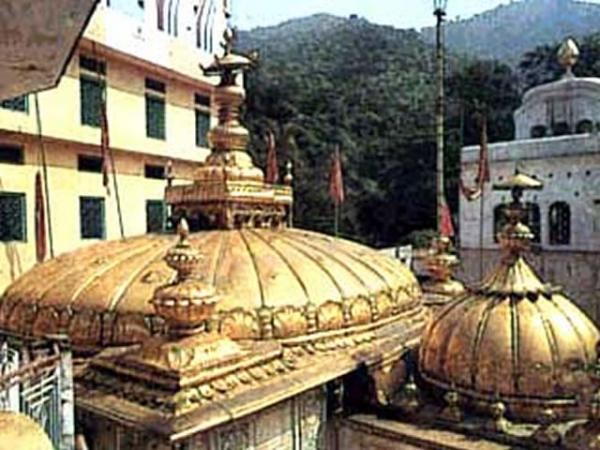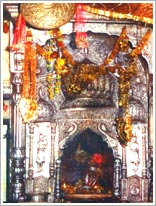India > Temples >Jwalamukhi Temple
Jwalamukhi Temple, Himachal Pradesh

Jwalamukhi is famous temple temple, 30 km south of Kangra valley of the goddess Jwalamukhi with flaming mouth. In this temple there is a copper pipe through which natural gas comes out and the priest of the temple lights this. This flame is worshiped as a manifestation of the goddess Jwalamukhi. The nine flames have been named after goddesses - Mahakali, Unpurna, Chandi, Hinglaj, Bindhya Basni, Maha Lakshmi, Saraswati, Ambika and Anji Devi, continuously burning without any fuel, or assistance, may be seen erupting from a rock side. Now housed in the shape of nature is worshipped as a goddess, known as Jwalamukhi. The great Mughal Emperor Akbar had visited this place to test its originality.
The temple belongs to the golden period when the gods roamed the Earth. Ancient legend speak if a time when demons lorded over the Himalaya mountains and harassed the gods. Led by Lord Vishnu, the gods decided to destroy them, they focused their strengths an huge flames rose from the ground. From that fire, a young girl took birth. She is regarded as Adishakti the first 'Shakti' known as Sati or Parvati, she grew up the house of Prajapati Daksha and later became the consort of Lord Shiva. Once her father insulted Lord Shiva and unable to accept this, she killed herself. When Lord Shiva heard of his wife's death his range knew no bounds and holding Sati's body he began stalking the three worlds. The other gods trembled before his wrath and appealed to Lord vishnu for help. Lord Vishnu let fly a volley of arrows which struck Sati's body and severed it to pieces. At the Places where the pieces fell, the fifty-one sacred 'shaktipeeths' came into being. Sati's tongue fell at Jwalaji (610 m) and the goddess is manifest as tiny flames that burns flawless blue through fissures in the age-old rock. Even the Pandavas are regarded to have visited this sacred place.
Jwalamukhi temple, Himachal Pradesh, according to another legend, the Goddess appeared in a dream to a Brahmin in far away South India, and directed him to proceed to the hills of Kangra in the shadow of the Dhauladhars and search for small tongues of flame leaping from the ground. The Brahmin, it is said responded discovered the sacred spot and in due course of time, erected a temple. Some people believe that Jwalamukhi represents the flaming mouth of Jalandhara, the demon whom Lord Shiva crushed to death by placing on him a huge mass of mountains. Popular beliefs and history are often intertwined at Jwalamukhi. For instance, it is a fact that Akbar the great Mughal Emperor visited the temple. The water course which today drips into a tank in the temple premises is said to have been constructed by Akbar in an attempt to douse the jets of flames in the temple.
The story goes that when the flames refused to be vanquished by the water channel specially constructed for the purpose, Akbar with utmost humility, became a devotee of the Goddess, and overcome by emotion, presented a chattra (umbrella) of gold to the goddess. But when leaving, the Emperor looked back with immense pride at the valuable gift that he had made to the Goddess, and was mortified to find that the gold had turned into copper! Later Akbar's son Jahangir invaded the Kangra valley and after seeing Jwalamukhi, wrote in his Tuzk (memories) near the temple and on the slope of the hill there is a sulphur mine and its heat causes flames to continually burst forth. They call it Jwalamukhi (flaming face or fiery mouth), and regard it as one of the idol's miracles?. Jahangir goes on to relate the legend of Shiva and Parvati and other stories connected with Jwalamukhi.
Histroy

In 1809, Maharaja Ranjit Singh visited the temple and after dyeing his hand in saffron, stamped an agreement in the temple premises with Raja Sansar Chand-the local ruler. Later after tasting success in the Afghan war, Maharaja Ranjit Singh gilded the roof of the Jwalamukhi temple as a thanksgiving. His son Kharak Singh, presented to the temple a pair of silver plated folding doors. It is recorded that in 1835 the temple had a score of the most beautiful dancing girls. Today all that has changed. While improved and faster modes of travel (there are daily flights to the Kangra valley and more than 500 buses and 200 cars/taxis touch Jwalamukhi each day during the peak Navratra-Nine Sacred Nights season) have ensured greater number of pilgrims than ever before, the administration of the temple has undergone a sea change.
In princely times, temple affairs were guided and supervised by the princely state of Nadaun. The raja (ruler) took upon himself the task of deputing particular Pujaris (priests) for daily rituals. After India gained Independence and the break-up of the feudal system, the pujaris of Jwalamukhi administered temple affairs to their advantage-and the detriment of pilgrims. As a result, in March 1987, the state government enforced an Act which empowered it to take over the administration of the temple. Under the new system, the Temple Officer-who is a government official-ensures that the 102 poojaris at the temple perform the rituals on a daily rotation basis. 40 percent of the temple's daily collection goes to the pujari on duty on that particular day. The remaining 60 percent is spent by the Government on improving and developing facilities for pilgrims and the poor and needy.
Puja
The deity is-offered Bhog of Rabri or thickened milk, Misri or candy, seasonal fruits, milk and arti is done. There is a mystic Yantar or diagram of the goddess, which is covered with shawls, ornaments and mantras are recited. The puja has different 'phases' and goes on practically the whole day. Arti is done five times in the day, Havan is performed once daily and portions of "Durga Saptasati" are recited.
How to Reach
Reach Jwalamukhi from Dharamshala by bus. Frequent buses pass through Kangra, distance 54 km and takes 2 hour. Kangra is 36 km away from Jwalamukhi. Trains from Pathankot to Joginder Nagar leave at 2.15 h, 4.50 h, 8.50 h, 9.35 h, 13.10 h, 16.00 h and reach Jwalamukhi road in 3 h and from there by bus to visit Jwalaji. Buses are also coming from Pathankot (123 km), Mandi (171 km), Manali (281 km). Simla (321 km), Palampur, Joginder Nagar and from several places of North India.
Photo Gallery

